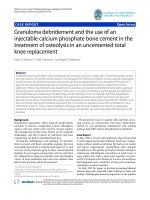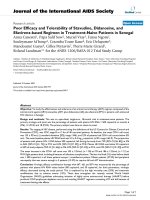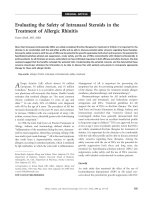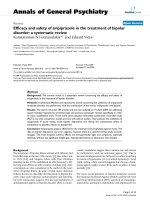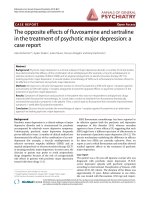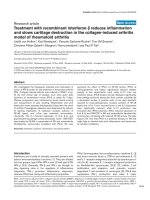Efficacy and safety of terbinafine in the treatment of dermatophytosis at Nghean provincipal leprosy, dermatology centre (2015-2016)
Bạn đang xem bản rút gọn của tài liệu. Xem và tải ngay bản đầy đủ của tài liệu tại đây (99.74 KB, 6 trang )
JOURNAL OF MILITARY PHARMACO-MEDICINE N07-2016
EFFICACY AND SAFETY OF TERBINAFINE IN THE TREATMENT
OF DERMATOPHYTOSIS AT NGHEAN PROVINCIPAL LEPROSY,
DERMATOLOGY CENTRE (2015 - 2016)
Nguyen Thai Dung*; Le Tran Anh**; Nguyen Khac Luc**
SUMMARY
Terbinafine - an allylamine drug has been shown to be fungicidal against dermatophytes and
has been approved by Vietnam’s Ministry of Health for treating dermatophytosis, but no study
on evaluating its effect and safety has been done in Vietnam. Objective: To evaluate the efficacy
and safety of the drug in the treatment of tinea. Subjects and methods: 29 patients with mild,
moderate lesions of ringworm take topical terbinafine 1% for 2 - 4 weeks (group 1); 27 patients
with extensive tinea or respond poorly to topical treatment take a combination of topical and oral
terbinafine for 1 - 14 days (group 2). Clinical and mycological assessments were made at 2 and
4 weeks after starting treatment. Results: The clinical cure after 2 weeks was 73.21% and
mycological cure was 85.71%; complete cure was 68.76%. The rate of complete cure in group 1
(82.76%) was higher than group 2 (50%; p < 0.05). 4 weeks after treatment, all patients were
cured completely. Patients taking only topical medication did not have undesirable effects.
Some patients in group 2 experienced side effects such as nausea (25.93%); flatulence (3.70%)
and dizziness (40.74%). Conclusion: Terbinafine is effective and safe in the treatment of ringworm.
* Key words: Ringworm; Terbinafine; Efficacy; Safety.
INTRODUCTION
Tinea is common disease in the
community and can be treated by topical
or systemic antifungal agents. There are
many drugs to treat the disease with
different advantages and disadvantages.
Terbinafine is an allylamine antifungal
with good profile of efficacy and safety.
Around the world, there have been many
studies assessing the effects of the drug
in the treatment of different types of tinea.
In Vietnam, the drug is also included in
the list of medications to treat ringworm
but no study has yet been done to
evaluate its effect and safety. This study
has been conducted to evaluate the efficacy
and safety of this drug in patients with
dermatophytosis at the Nghean Provincial
Leprosy, Dermatology Centre.
SUBJECTS AND METHOD
1. Patients.
Patients with ringworm and agree to
be involved in the study.
2. Materials.
Drugs: Terbinafine (brand name TERBISIL)
250 mg (SANTA FARMA ILAC SANAYII
A.S Turkey). TRIGENOL cream 1%; (NEW
GENE PHARM Inc., Korea).
KOH solution 10 - 20%; Sabouraud
medium.
* Nghean Provincial Leprosy - Dermatology Centre
** Military Medical University
Corresponding author: Le Tran Anh ()
53
JOURNAL OF MILITARY PHARMACO-MEDICINE N07-2016
3. Study design.
Uncontrolled clinical trial.
Patients with ringworm (have lesions
and positive mycology test by direct
examination or culture) were graded as
mild, moderate and severe according to
criteria by Vietnam Dermatology Association
(mild: 1 lesion and lesion area < 1 hand;
moderate: 2 - 5 lesions and/or area of
lesion from 2 - 5 hands; severe: more
than 5 lesions and/or lesions covering an
area of more than 5 hands). 29 patients
with mild or moderate lesions of ringworm
take topical terbinafine 1% daily for 2 - 4
weeks (group 1); 27 patients with extensive
tinea or responding poorly to topical
treatment take a combination of topical
and oral terbinafine (250 mg twice a day
for 1 - 14 days (group 2). Mycological and
clinical assessments were made after
2 and 4 weeks of treatment. Clinical
response was qualified as following:
clinical cure: clearing of 70 - 100% of
lesions; decrease: clearing 50 - 69% of
lesions; not curing: clearing < 50% of
lesions. Complete cure was defined as
mycological cure (negative microscopy)
and clinical cure.
* Site and time:
Nghean Provincial Leprosy, Dermatology
Centre and fungal laboratory, Department
of Parasitology, Vietnam Military Medical
University.
Time: October 2015 to August 2016.
* Statistical analysis: by SPSS 11.5
software.
* Ethnic: this study was approved by
the ethics committee of Vietnam National
Institute of Malariology Parasitology and
Entomology. All patients were well-informed
and voluntarily provided information. The
information is kept confidentially and used
for research only.
RESULTS AND DISCUSSION
Table 1: Demographic characteristics of patients (n = 56).
Criteria
Age
Number
Percentage (%)
2-9
2
3.57
10 - 19
14
25.00
20 - 29
19
33.93
30 - 39
11
19.64
40 - 49
1
1.79
50 - 59
6
10.71
60 - 69
3
5.36
Group
30.02 ± 15.067
Mean ( X ±SD)
Gender
Male
34
60.71
Female
22
39.29
The average age of patients was 30.02 years old; mostly men (60.71%).
The patients involved in the study were characterized by ringworm, a disease mostly
affects male and young people [1, 3].
54
JOURNAL OF MILITARY PHARMACO-MEDICINE N07-2016
Table 2: Treatment regimens according to characteristics of lesions (n = 56).
Group
Criteria
Total
1
2
Number
Percentage
Mild
26
2
28
50.00
Moderate
3
18
21
37.50
Severe
0
7
7
12.50
1
26
4
30
53.57
2-5
3
16
19
33.93
>5
0
7
7
12.50
Small
25
2
27
48.21
Medium
4
18
22
39.29
Large
0
7
7
12.50
Corporis
19
22
41
73.21
Crusis
7
12
19
33.93
Hand
0
3
3
5.36
Feed
2
3
5
8.93
Face
2
4
6
10.71
Head
1
0
1
1.79
29
27
56
100
Grade
Number of
lesions
Size of
lesions
Locations of
lesions*
Total
(* Some patients have multiple lesions)
Topical terbinafine was first-line treatment for patients with mild or moderate lesions
while oral terbinafine for extensive tinea that responded poorly to topical treatment
alone. The regimen based on characteristics of lesions focusing on disease severity,
lesion size, lesion location was consistent with the guidance of the Ministry of Health [4]
and recommendation by some authors [10].
Table 3: Results after 2 weeks of treatment (n = 56).
Mycology
Criteria
Clinical
Total
Total
Negative
Positive
Number
Percentage
Cure
38
3
41
73.21
Decrease
10
5
15
26.79
Not cure
0
0
0
0
Number
48
8
56
100
Percentage (%)
85.71
14.29
After 2 weeks of treatment, the rates of clinical, mycological and complete cure were
73.21%; 85.71% and 68.76%, respectively.
55
JOURNAL OF MILITARY PHARMACO-MEDICINE N07-2016
Table 4: Impact of lesion on treatment effect.
Group
Criteria
Grade
Total
1
2
Mild
3
1
4
Moderate
2
8
10
Severe
0
4
4
Number of
lesions
1
3
3
6
2-5
2
6
8
>5
0
4
4
Size of lesions
Small
2
1
3
Medium
3
8
11
Large
0
4
4
5
13
18
Total
There were 18 patients with different grades, number and extent of lesions. The
complete cure rate in group 1 (82.76%) was higher than that in group 2 (50%; p < 0.05).
Table 4: Results after 4 weeks of treatment.
Criteria
Clinical
Mycology
Number
Percentage
Cure
49
87.5
Not cure
0
0
Not return
7
12.5
100.0
Total
56
Negative
6
Positive
0
Not return
2
Total
8
After 4 weeks, 100% of the examined
cases were completely cured. Two cases
had a positive mycological test at the first
assessment but did not come back to
retest.
The results showed that the drug has a
good efficacy on the treatment of tinea.
These results are similar to many other
studies evaluating the efficacy of terbinafine
with rates of complete cure of about 70 100%. Vidhya Lakshmi CP et al (2003)
studied the efficacy of terbinafine topical
56
treatment of tinea corporis and tinea
cruris and found that after 2 weeks of
treatment 100% of patients had clinical
cure and negative test [8]. Bonifaz A,
Saul A (2000) using terbinafine cream
(1 week topical treatment of tinea corporis
and tinea cruris) found that the mycological
cure rate was 94% and complete cure
rate was 72% [6]. Ledezma E (1999)
found the cure rate of terbinafine 1%
cream evaluated after 16 days was
71%; and after 30 days was 75% [9].
JOURNAL OF MILITARY PHARMACO-MEDICINE N07-2016
In general, topical use of antifungal
drugs can be effective in infections of
limited area but oral formulations may be
required for infections of more severe or
more widespread presentation [5]. Patients
with spreading lesions or at special locations
such as nails, hair or thick skin areas
require oral antifungal therapy. In the study,
those patients with spread or recurrent
lesion were prescribed oral terbinafine
combined with topical medication. This
regiment had good efficacy in 100% of reexamined patients completely cured. Oral
terbinafine was demonstrated efficacy in
the treatment of ringworm even in a short
duration, in special types of the disease or
on patients with disorder of immunity or
endocrine. The clinical and mycology cure
rate two weeks after taking oral
terbinafine alone were 47.1% and 47.1%
in patients taking the drug for two days
and 66.7% and 66.7% for three days [13].
Rich P (2001) assessed the efficacy of
short-duration oral terbinafine six weeks
after the treatment, the rate of cure was
100% for HIV-infected patients and 83%
for patients with diabetes [11]. With tinea
imbricata, a special type of tinea caused
by Trichophyton concentricum with lesion
spread peripherally over many years,
4 weeks of oral medication had a complete
cure rate of 100% and recurrent rate 16%
compared to that of itraconazole (89%
and 75%, respectively) [7].
Table 6: Side effects.
Effects
Group 1 (n = 26)
Group 2 (n = 27)
Number
Percentage
Number
Percentage
Nausea
0
0
7
25.93
Constipation
0
0
0
0
Flatulence
0
0
1
3.70
Diarrhea
0
0
0
0
Dizziness
0
0
11
40.74
Excitement
0
0
0
0
Skin lesion
0
0
0
0
(* the information of side effects could not be completed in 3 patients)
Some patients in group 2 suffered from
side effects such as nausea, flatulence
or dizziness. The results showed that
terbinafine was relatively safe to use.
Research by Rich P (2001) also found
that even patients with HIV infection or
diabetes did not show any adverse effects
when taking terbinafine [11]. Although
there is some concern about the potential
effects of elevations of liver enzyme [5],
but this risk is very low. Skorepova M
(2004) found that the rate of liver damage
after treatment with terbinafine for
onychomycosis was 1/45.000 - 50.000
patients, equivalent to paracetamol, a
very common drug (5.5/100,000) [11].
Due to some difficulties, liver function
tests had not been done, but with a short
duration of terbinafine, the risk is very low.
CONCLUSION
Through a research on the efficacy
and safety of terbinafine on 56 patients,
we found the following results:
57
JOURNAL OF MILITARY PHARMACO-MEDICINE N07-2016
- 2 weeks after treatment, the rate of
clinical, mycological and complete cure
were 73.21%; 85.71% and 68.76%,
respectively. The rate of complete cure of
topical therapy was 82.76%; higher than
that of combination between topical and
oral therapy (50%; p < 0.05).
- 4 weeks after treatment, all patients
were completely cured.
- Some patients experienced side
effects when taking oral terbinafine:
nausea (26.2%); flatulence (3.85%) and
dizziness (42.31%).
REFERENCES
1. Tôn Nữ Phương Anh, Ngô Thị Minh
Châu, Nguyễn Thị Hóa, Nguyễn Phước Vinh,
Hà Thị Ngọc Thúy. Nghiên cứu tình hình bệnh
nấm ở da của các bệnh nhân đến xét nghiệm
tại Khoa Ký sinh trùng, Bệnh viện Trường Đại
học Y Dược Huế. Phòng chống sốt rét và các
bệnh ký sinh trùng. 2012, số 4, tr.59-71.
2. Lê Trần Anh, Vũ Văn Tiến. Một số yếu
tố ảnh hưởng bệnh nấm da trên bệnh nhân
đến khám và điều trị tại Bệnh viện Quaan y
103 (2013 - 2014). Phòng chống sốt rét và
các bệnh ký sinh trùng. 2014, tập 82, số 5,
tr.62-68.
3. Trương Quang Ánh, Tôn Nữ Phương
Anh. Bước đầu khảo sát tình hình nhiễm nấm
da và nấm ngoại biên ở bệnh nhân được xét
nghiệm nấm tại Khoa Ký sinh trùng, Bệnh
viện Trường Đại học Y khoa Huế trong năm
2003. Phòng chống sốt rét và các bệnh ký
sinh trùng. 2004, số 6, tr.80-85.
4. Bộ Y tế. Hướng dẫn chẩn đoán và điều
trị các bệnh da liễu ban hành kèm theo quyết
định số 75 /QĐ-BYT ngày 13/01/2015. 2015.
5. Anaissie EJ, McGinnis MR, Pfaller MA,
Anstead GM, Arora A. Clinical Mycology
(second edi). Elsevier Inc. 2009.
58
6. Bonifaz A, Saul A. Comparative study
between terbinafine 1% emulsion-gel versus
ketoconazole 2% cream in tinea cruris and
tinea Corporis. Eur J Dermatol. 2000, 10 (2),
pp.107-109.
7. Budimulja U, Kuswadji K, Bramono S,
Basuki J, Judanarso LS, Untung S et al. A
double-blind, randomized, stratified controlled
study of the treatment of tinea imbricata with
oral terbinafine or itraconazole. Br J Dermatol.
1994, 130, Suppl 43, pp.29-31.
8. CP. Vidhya Lakshmi, Girish M.
Bengalorkar, V. Shiva Kumar. Clinical efficacy
of topical terbinafine versus topical luliconazole
in treatment of tinea corporis/tinea cruris
patients. British Journal of Pharmaceutical
Research. 2013, 3 (4), pp.1001-1014.
9. Ledezma E, JC Lopez, Marin P, Romero
H, G Ferrara, De Sousa L et al. Ajoene shortterm in the topical treatment of tinea cruris
and tinea corporis in humans. Randomized
comparative
study
with
terbinafine.
Arzneimittelforschung. 1999, 49 (6), pp.544-547.
10. M. Pereiro Ferreirós Jr, FJ GarcíaMartínez, J. Alonso-González. Update on the
treatment of superficial mycoses. Actas
Dermosifiliogr. 2012, 103 (9), pp.778-783.
11. Rich P, Houpt KR, Lamarca A, Lovén
KH, Marbury TC, Matheson R, Miller B, Smith
S, Wolf J. Tinea corporis/tinea cruris research
group, safety and efficacy of short-duration
oral terbinafine for the treatment of tinea or
tinea cruris corporis in subjects with HIV
infection or diabetes. Cutis. 2001, Jul, 68
(1 Suppl), pp.15-22.
12. Skorepova M. Risk of liver damage
caused by modern systemic antimycotics.
Ces-lov Derm. 2004, 79 (2), pp.59-61.
13. Shiraki Y, Hiruma M, Inoue A,
Matsushita A, Ogawa H. A short-term
treatment of tinea cruris corporis with oral
terbinafine and tinea. [Article in Japanese]
Nihon Ishinkin zasshi Gakkai. 2003, 44 (2),
pp.121-125.


